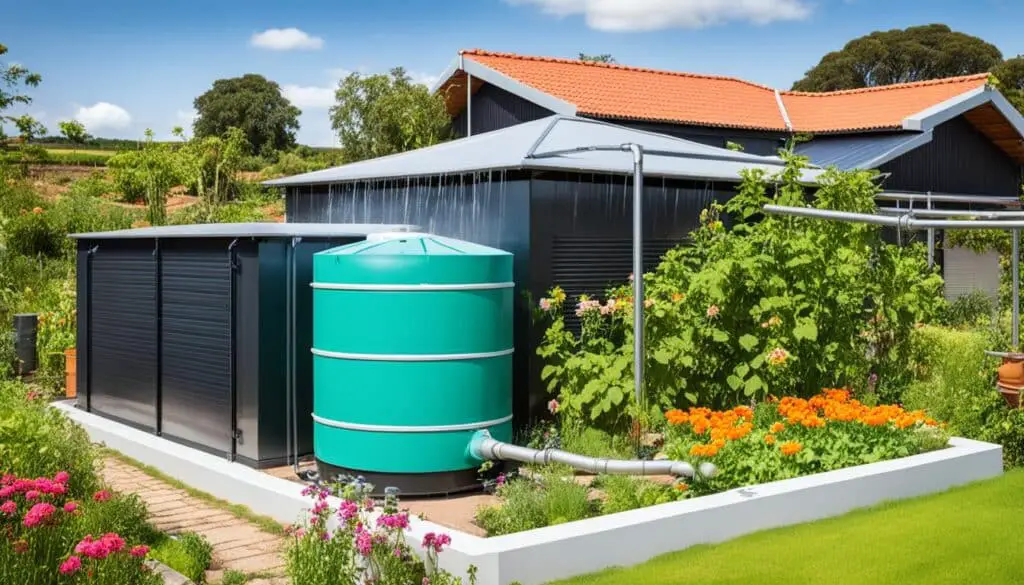As an expert in sustainable practices, I’m excited to introduce you to the world of rainwater harvesting. In this article, we’ll explore the numerous benefits of rainwater harvesting and learn how you can get started with this eco-friendly practice.
Rainwater harvesting involves collecting and storing rainwater for various purposes, eliminating the need for external water sources. Not only does this practice help conserve our precious water resources, but it also offers a range of advantages for individuals and the environment.
By implementing rainwater harvesting, you can reduce your dependence on groundwater and surface water, thus ensuring the long-term sustainability of these valuable resources. Additionally, capturing rainwater prevents runoff, minimizing the risk of erosion and flooding in your surroundings.
One of the key benefits of rainwater harvesting is its positive impact on your wallet. By utilizing collected rainwater for activities such as irrigation, toilet flushing, and laundry, you can significantly reduce your water bills. Imagine the savings you can enjoy by utilizing free rainwater for these purposes.
Moreover, rainwater harvesting can also contribute to your overall well-being. When used for bathing or washing, rainwater is often gentler on the skin and hair compared to chemically treated municipal water. However, it’s important to ensure proper filtration or treatment before consuming rainwater, as it may contain contaminants from the atmosphere or collection surfaces.
If you’re interested in getting started with rainwater harvesting, there are a few crucial steps to follow. Begin by evaluating the local climate and rainfall patterns to determine the viability of collecting substantial amounts of water. Assess the available space for installing the appropriate rainwater collection system, ranging from simple rain barrels to more complex setups with storage tanks and filtration.
Before implementing your rainwater harvesting system, it’s essential to check local regulations and obtain any necessary permits. Adhering to these guidelines will ensure a smooth and compliant installation process.
Key Takeaways:
- Rainwater harvesting conserves groundwater and surface water resources.
- It reduces runoff, preventing erosion and flooding.
- Rainwater harvesting can lead to significant cost savings by reducing water bills.
- Properly harvested rainwater provides a source of safe and gentle water for non-potable uses.
- Before getting started, evaluate local climate, space availability, and comply with regulations.
Environmental Benefits of Rainwater Harvesting
Rainwater harvesting is not only beneficial for individuals but also plays a significant role in environmental conservation. By implementing rainwater harvesting systems, we can reduce the demand for groundwater and surface water, ensuring the sustainable use of these valuable resources.
One of the key environmental benefits of rainwater harvesting is the reduction of runoff. Instead of rainwater flowing offsite and potentially causing erosion and flooding, it is captured and utilized effectively. This helps to mitigate the negative impacts of excessive runoff on our ecosystems.
“Rainwater harvesting helps conserve water resources by capturing and utilizing rainwater instead of allowing it to go to waste.”
Reducing the strain on local water systems is another significant advantage of rainwater harvesting. By relying more on collected rainwater, we lessen the burden on municipal water supplies, especially during periods of high demand. This, in turn, helps to maintain water availability for all users and ensures the sustainable management of water resources.
Furthermore, rainwater harvesting contributes to a decrease in the energy required for water treatment and distribution. Since rainwater is typically cleaner and requires less treatment compared to groundwater or surface water, less energy is consumed in the purification and pumping processes. This reduction in energy consumption directly translates into lower carbon emissions and a smaller environmental footprint.
Overall, rainwater harvesting provides invaluable environmental benefits, including resource conservation, reduced runoff, less strain on local water systems, and decreased energy consumption. By implementing rainwater harvesting systems, we can actively contribute to a more sustainable and eco-friendly future.
Environmental Benefits of Rainwater Harvesting
| Benefit | Description |
|---|---|
| Conservation of groundwater and surface water | Rainwater harvesting reduces the demand for these valuable resources. |
| Reduction in runoff | Capturing and utilizing rainwater mitigates erosion and flooding caused by excessive runoff. |
| Less strain on local water systems | Rainwater harvesting decreases reliance on municipal water supplies, ensuring water availability for all users. |
| Decreased energy consumption | Rainwater requires less treatment and pumping, resulting in lower energy usage and carbon emissions. |
Economic Benefits of Rainwater Harvesting
Rainwater harvesting offers not only environmental benefits but also significant economic advantages. By utilizing collected rainwater for various household activities, individuals and businesses can reduce their water bills and decrease their reliance on municipal water supplies. This, in turn, can lead to substantial cost savings and contribute to long-term financial sustainability.
One of the key economic benefits of rainwater harvesting is the reduction in water expenses. By using harvested rainwater for activities such as irrigation, toilet flushing, and laundry, households can save money by minimizing their consumption of treated municipal water. This can be especially advantageous in areas where water rates are high or during periods of water scarcity when prices may increase.
Moreover, rainwater harvesting systems can help businesses reduce their operational costs. By implementing rainwater collection and storage systems, businesses can decrease their reliance on expensive municipal water supplies and rely more on the free resource of rainwater. This can result in significant savings, particularly for industries that require large amounts of water for their operations such as agriculture, manufacturing, and hospitality.
Additionally, rainwater harvesting can offer financial incentives for both households and businesses. Some government agencies and local municipalities provide tax incentives or rebates for implementing rainwater harvesting systems. These incentives can help offset the initial installation costs and provide additional savings in the long run. It is advisable to check with local authorities to determine eligibility and take advantage of these potential benefits.
“Rainwater harvesting systems can help businesses reduce their operational costs.”
| Benefits | Households | Businesses |
|---|---|---|
| Reduced water bills | Significant savings by utilizing collected rainwater for various activities | Decreased reliance on expensive municipal water supplies |
| Financial incentives | Households may qualify for tax incentives or rebates | Potential tax incentives or rebates offered by some government agencies |
Implementing a rainwater harvesting system can initially require an investment in infrastructure and equipment. However, the long-term economic benefits, such as reduced water bills and potential financial incentives, make it a worthwhile endeavor. By embracing rainwater harvesting, individuals and businesses can not only contribute to water conservation efforts but also enjoy the economic advantages that come with it.
Health Benefits of Rainwater Harvesting
Rainwater harvesting offers not only environmental and economic advantages but also health benefits when used for non-potable purposes. When harvested properly, rainwater can serve as a safe and dependable source of water that can be gentler on the skin and hair compared to water treated with chemicals in municipal systems.
As rainwater does not go through the same treatment process, it lacks the added chemicals, such as chlorine, which can sometimes cause dryness and irritation. This makes rainwater ideal for bathing and washing, offering a more refreshing and soothing experience for individuals.
“Using rainwater for bathing has made a noticeable difference in the health and appearance of my skin. It feels softer, healthier, and less prone to dryness,” says Jane Reynolds, a long-time rainwater harvesting enthusiast.
However, it is important to note that rainwater should not be consumed without appropriate filtration or treatment. Rainwater, as it falls, can pick up contaminants from the atmosphere or collection surfaces, posing potential health risks if not properly addressed. Implementing a filtration system is crucial to ensure the removal of any impurities before rainwater is utilized for potable purposes.
Key Health Benefits of Rainwater Harvesting
- Gentler on skin and hair when used for bathing and washing
- Reduces exposure to chemicals added during municipal water treatment
- Potential improvement in skin health and appearance
How to Get Started with Rainwater Harvesting
Implementing a rainwater harvesting system requires careful planning and consideration. Here are the essential steps to get started:
Evaluate Local Climate and Rainfall Patterns
Begin by assessing the local climate and rainfall patterns in your area. This will help you determine the potential for collecting significant amounts of rainwater. Understanding the average rainfall and seasonal variations will guide your decision-making process.
Assess Available Space and Choose a System
Next, evaluate the available space on your property for installing a rainwater collection system. Depending on the available space, you can choose from a range of options, including:
- Rain barrels: Ideal for smaller spaces and can be placed near downspouts to collect rainwater.
- Underground tanks: Suitable for larger properties with limited space for above-ground storage.
- Above-ground tanks: Provides a larger storage capacity and allows easy access for maintenance.
Consider your specific needs and the amount of water you wish to collect when selecting a rainwater harvesting system.
Check Local Regulations and Obtain Permits
Prior to implementing a rainwater harvesting system, it is essential to check with your local authorities regarding any regulations or permits required. Some areas may have specific guidelines or restrictions on rainwater harvesting, particularly for larger-scale systems. Ensure compliance with local regulations to avoid any legal complications.
“Before implementing a rainwater harvesting system, it is important to evaluate the climate, choose a suitable system, and comply with local regulations.”
– Experts in Sustainable Water Management
By following these steps, you can get started with rainwater harvesting and contribute to sustainable water management in your community.
| Benefits of Getting Started with Rainwater Harvesting |
|---|
| Conserves water resources |
| Reduces water bills |
| Supports environmental sustainability |
| Minimizes strain on local water systems |
Conclusion
Rainwater harvesting offers numerous benefits for individuals and businesses, making it a sustainable practice worth considering. By collecting and utilizing rainwater, we can contribute to environmental conservation, experience cost savings, and potentially enjoy health advantages.
Implementing a rainwater harvesting system requires careful planning and adherence to local regulations. However, the long-term benefits of reducing water bills, conserving valuable resources, and decreasing the strain on water systems make it a worthwhile investment.
Start exploring rainwater harvesting today and make a positive impact on water resource management. With proper planning and the right equipment, you can enjoy the rewards of this eco-friendly practice, helping to create a more sustainable future.
FAQ
What is rainwater harvesting?
Rainwater harvesting is a sustainable practice that involves collecting and storing rainwater for various purposes.
What are the benefits of rainwater harvesting?
Rainwater harvesting helps reduce the demand for groundwater and surface water, conserves resources, reduces runoff, decreases the strain on local water systems, and saves costs.
How does rainwater harvesting conserve resources?
By eliminating the need for external water sources, rainwater harvesting reduces the demand for groundwater and surface water.
How does rainwater harvesting reduce runoff?
Rainwater is captured and utilized instead of flowing offsite, reducing the potential for erosion and flooding.
How does rainwater harvesting save costs?
By using collected rainwater for activities such as irrigation, toilet flushing, and laundry, households and businesses can decrease their reliance on municipal water supplies and reduce water expenses.
Is rainwater safe for use?
When harvested properly, rainwater can be a safe and reliable source of water for various non-potable uses. However, it should not be consumed without appropriate filtration or treatment.
How do I get started with rainwater harvesting?
To get started, evaluate the local climate and rainfall patterns, assess available space for a collection system, check local regulations, and obtain any necessary permits.



